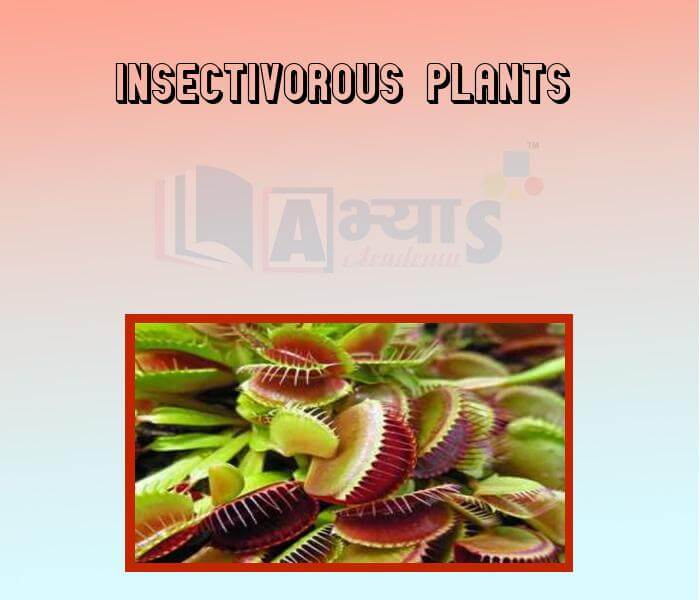Insectivorous Plants












Insectivorous Plants
Insectivorous plants or Carnivorous plants: There are the plants that derive some or most of their nutrients by trapping and consuming animals mainly insects. These plants grow where soil is deficient in some nutrients. Example: Pitcher plant. These are actually green plants which can make their own food. But, they gain some of their nutrition from insects, trapped by the plants themselves. These plants mostly grow in the soil which is poor in nitrogen. So, they trap insects to get nitrogenous compounds without manufacturing them. The examples are venus fly trap, sundew, bladderworf and pitcher plant.
Venus flytrap: Insects are lured by the nectar into the jaw-like leaf trap of the Venus flytrap plant. Once the insect sits on the leaves, the jaws clampshut and the insect is trapped in it. The plant immediately secretes digestive juices that first drown and then dissolve the insect.
Sundew: Its leaves are covered with hair-like structures (tentacles) that ooze a sticky dew like substance that glitters in the sunlight. When an insect lands on the sticky tentacles of a sundew plant, it struggles to free itself, but this struggling stimulates the tentacles tighten their grip. The tentacles then produce a digestive juice that dissolves the victim.
Pitcher plant: The leaves of the pitcher plants extend into tendrils and then swell like balloons. Pitchers have a lid that acts as a landing platform for insects. It also helps to prevent rainwater from diluting the digestive juices inside the pitcher. The inside of the pitcher is lined with downward pointing hair, which do not allow any insect to climb back and escape. Insects are attracted to the pitcher by its scent or colour. When they enter inside, the lid closes. They slide down the walls and drown into the digestive juices at the bottom, which dissolve the insect.
Bladderwort: The stem and slender leaves of bladderworts bear a large number of very small, pear-shaped bladders. The bladders have small membrane covers that act as doors. Their oval shapes create a vacuum that sucks in tiny insects within one-thousandth of a second, when they trigger the hair that are located around the doors. Digestive juices are then released inside the bladders to digest the prey.
A carnivorous plant is _______________________ | |||
| Right Option : A | |||
| View Explanation | |||
Students / Parents Reviews [10]
Abhyas is a complete education Institute. Here extreme care is taken by teacher with the help of regular exam. Extra classes also conducted by the institute, if the student is weak.

Om Umang
10thMy experience with Abhyas academy is very good. I did not think that my every subject coming here will be so strong. The main thing is that the online tests had made me learn here more things.

Hiya Gupta
8thIt was a good experience with Abhyas Academy. I even faced problems in starting but slowly and steadily overcomed. Especially reasoning classes helped me a lot.

Cheshta
10thBeing a parent, I saw my daughter improvement in her studies by seeing a good result in all day to day compititive exam TMO, NSO, IEO etc and as well as studies. I have got a fruitful result from my daughter.

Prisha Gupta
8thMy experience was very good with Abhyas academy. I am studying here from 6th class and I am satisfied by its results in my life. I improved a lot here ahead of school syllabus.

Ayan Ghosh
8thAbhyas Methodology is very good. It is based on according to student and each child manages accordingly to its properly. Methodology has improved the abilities of students to shine them in future.

Manish Kumar
10thAbout Abhyas metholodology the teachers are very nice and hardworking toward students.The Centre Head Mrs Anu Sethi is also a brilliant teacher.Abhyas has taught me how to overcome problems and has always taken my doubts and suppoeted me.

Shreya Shrivastava
8thMy experience with Abhyas is very good. I have learnt many things here like vedic maths and reasoning also. Teachers here first take our doubts and then there are assignments to verify our weak points.

Shivam Rana
7thOne of the best institutes to develope a child interest in studies.Provides SST and English knowledge also unlike other institutes. Teachers are co operative and friendly online tests andPPT develope practical knowledge also.

Aman Kumar Shrivastava
10thI have spent a wonderful time in Abhyas academy. It has made my reasoning more apt, English more stronger and Maths an interesting subject for me. It has given me a habbit of self studying
